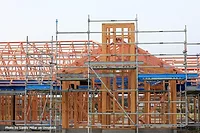Built from Scratch
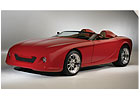
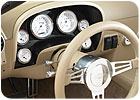
Dickirson worked in the Product Engineering Office of the Ford Motor Co. for 36 years, beginning in the drafting room and finishing as manager of the Visteon Product Development System. And then one day, a dilemma: What to do about retirement? Dickirson knew he still had what it took to work for Ford, but suddenly something else was on his mind, an idea he'd been kicking around since he was a kid.
"It was my boyhood dream to design and build a vehicle from scratch," Dickirson says. "Near the end of my career, I began firming up the vision I'd had of forming a team of professionals with the skills and enthusiasm for undertaking a major project outside the umbrella of a large company. I wanted to have people on the team who loved cars and had the real-world technical experience in their specialty areas that would ensure project success."
His decision to leave Ford made, Dickirson once again headed down the road less traveled. All the conventional trappings of retirement - the golf, the trips around the world - would take a back seat to the one thing that truly mattered. Gene Dickirson and his colleagues would build a one-of-a-kind car, a car that would eventually bear his name.
So began the GDT Speedster project.
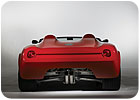
Building the Perfect Beast
Dickirson knew from the outset that realizing his dream would be a costly venture, but it was a tab he was all too happy to pick up himself. And rather than turning the Speedster project into a matter of one man's singular vision, he instead chose to make it a collaborative effort, taking suggestions from team members at informal lunch meetings in the weeks and months leading up to the start of actual assembly. At its core, the decision-making process was largely a democratic one: Recommendations and proposals for each assembly element were subject to a consensus vote before being included in the vehicle's final design.Of course, this planning stage would prove to be just the tip of the proverbial iceberg. Weeks, months and, eventually, years of work awaited Dickirson and his crew - but would they be up to the challenge?
It probably bears mentioning here that the design and assembly of one-of-a-kind cars is hardly commonplace. According to Dickirson, only one or two scratch-built vehicles are completed in any given year, and once everything is in place - fenders buffed to a glossy shine, a pair of fuzzy dice dangling from the rearview mirror - there's always the very exclusive one-of-a-kind car sales market to contend with. But more on that later.
For its part, Dickirson's team tackled the assembly of the Speedster with the calculated tenacity one would expect of those with years of experience in the automobile industry. A typical workweek saw ideas grow from sketches to detailed CAD schematics to actual finished components that were refined and readied for installation. Altogether, more than 2,000 parts were designed and fabricated for the GDT Speedster, with a few major elements - the engine, transmission, steering and braking systems, rear axel, and engine-cooling module - coming from a 1994 Corvette.
"The level of output was essentially constant for almost six years," Dickirson says. "I worked on the project six hours a day, six days a week, for 5.7 years. The other team members participated heavily during the phases where their area of expertise was being used. The team members who were still working full-time at Ford or Visteon did their work on the project at night and on weekends."
And what of the cost of chasing one's dream? Dickirson says the final tally for parts and services on the Speedster project came to approximately $100,000 - a sizable chunk of money for one car, but a mere drop in the bucket compared to the millions OEMs spend on research and development for prototype cars regularly seen on the auto show circuit.

A Sticky Situation
Dickirson says adhesives and sealants were key to the success of the GDT Speedster project."The vehicle's windshield is adhesively bonded to the steel support structure," he says. "And sealants are used to prevent water and engine compartment fumes from entering the passenger compartment."
So important were the products used that team members tested more than 40 different adhesives and sealants to determine their relative merits before incorporating them into the final assembly. Dickirson estimates that at least 17 different adhesive and sealant products were used in the fabrication of the Speedster, from Devcon 2-Ton Epoxy (for fiberglass repairs) to Lord Fusor Urethane Sealer/Adhesive 800 (for sealing underbody weld seams).
Adhesives also proved instrumental in helping Dickirson and his crew to overcome one of the biggest challenges they faced during the Speedster project: Fitting and attaching the vehicle's fiberglass body panels to its steel support structure. Both the hood and rear deck panels weighed 100 lbs each and had to align with each other and the support structure within .5 mm - a simple enough task on an assembly line, but one made infinitely more difficult when assembling a vehicle by hand. The Speedster team settled on Plexus A0420 Methacrylate for the major joints and Devcon Plastic Welder Methacrylate for the smaller ones.
"The other challenge we had was finding (components) suppliers that would work with us," Dickirson says. "Most are used to dealing with the big OEMs and don't want to devote their resources for one or two parts at a price much lower than they normally charge."
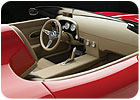
Selling Out
"The most rewarding aspect of the project was the first ‘start and drive away,'" Dickirson says eight months after the Speedster's completion. "It was exciting to see 2,000-plus parts come together as a complete vehicle that actually started and was driven around the block."Despite this, Dickirson has no intention of holding onto his dream. From day one, it's always been his plan to sell the car in order to recoup his expenses. The remaining profit will be divided amongst the rest of the team - a gesture of goodwill for the combined 13,000 hours they devoted to the project.
Which brings us back to that pesky one-of-a-kind-car sales market, and a very important question: Who on earth will shell out $200,000 (Dickirson's current asking price) for a scratch-made car?
"The market is limited to serious collectors who have the resources and interest in any particular car," Dickirson says. "I estimate perhaps only 10 in the world are interested - and have the money - to purchase the GDT Speedster."
And after the car sells? Dickirson is ready with an answer to this question as well.
"The team members and I are eager to start on the next vehicle," he says. "It will look different from the first because the body panels will be uniquely styled just for the second car. We're just waiting for the first car to sell before we start on number two. It's important that we determine the market pull for this type of vehicle."
For more information on the GDT Speedster, visit http://www.gdtspeedster.com .
The author would like to thank Gene Dickirson for his cooperation in the writing of this article.
SIDEBAR: The GDT Speedster Team
Musa Azzouz - Body structures engineer (retired), Ford Motor Co., Product Engineering Office, and instructor at Lawrence Technological UniversityProvided design direction for the frame, underbody and restraint anchors to ensure the vehicle would be strong enough for its intended purpose.
Chuck Carlson - Ford Motor Co., Product Engineering Office (retired)
Participated in essentially every aspect of the Speedster project, including design and fabrication.
Lawrence Conger - Owner, Digital Design Inc.
Created the exterior body surfaces and the instrument panel surface for the GDT Speedster using ICEM/Surf, a powerful CAD tool.
Gene Dickirson - Engineering manager, Ford Motor Co., Product Engineering Office (retired)
Formed the team and led the design, fabrication and financing for the GDT Speedster project.
Dave Maran - Visteon Program Management Office
Provided numerous suggestions for the vehicle and fabricated several wood models and welding fixtures used in the project.
Keith Rogalski - Visteon Product Engineering
Provided assistance with non-contact digital scanning.
Larry Ronzi - Ford Motor Co., Design Center (retired)
Sculpted a 1:8 clay model of the Speedster, working closely with Craig Sandvig on the overall design of the vehicle.
Craig Sandvig - Ford Motor Co., Design Center
Assumed overall responsibility for the design (styling) of the exterior, interior and under hood of the vehicle. Also polished all aluminum parts and assisted with the fabrication of several components.
James Wilber - Visteon Corp., Electronics Product Engineering
Assisted with the design and fabrication of the wiring system, instrument panel gauges and A/C registers. Also assisted Dickirson in resolving CAD file translation issues.
Sidebar information courtesy of Gene Dickirson.
Links
Looking for a reprint of this article?
From high-res PDFs to custom plaques, order your copy today!




